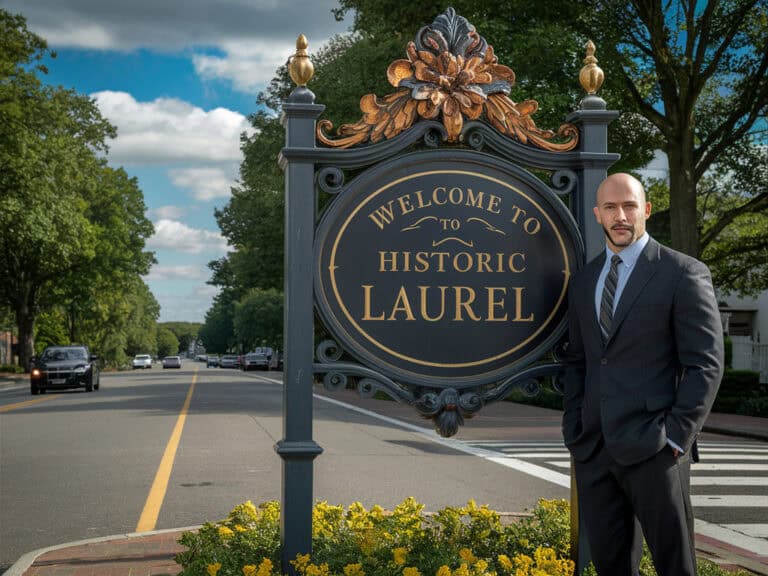Imagine you’re driving down the highway, and suddenly, a fully loaded big rig loses control and collides with your car. In the wake of the collision, there’s a tumultuous blend of hurt, destruction, and an emotional tempest. Now comes the challenging part – proving liability in a truck accident case. It’s not just about pointing fingers; it’s about piecing together evidence to paint a clear picture of what happened.
This article will guide you through understanding negligence, identifying who’s at fault (be it the driver, trucking company or manufacturer), and leveraging Federal Motor Carrier Safety Regulations to support your claim. We’ll also dive into practical steps for gathering crucial evidence in Maryland’s legal landscape. Moreover, we’re going to navigate the tricky obstacles claimants encounter while establishing fault and unveil tactics for surmounting these challenges with finesse.
Continue exploring, and you’ll arm yourself proving liability in a truck accident case with insights that might profoundly shape your quest for fairness following these distressing events.
Table Of Contents:
- Understanding the Basics of Truck Accident Liability
- Key Factors Influencing Liability in Truck Accidents
- Steps to Prove Liability in Maryland Truck Accidents
- The Role of Federal Regulations in Truck Accident Claims
- Challenges in Proving Liability and How to Overcome Them
- FAQs in Relation to Proving Liability in a Truck accident Case
- Conclusion
Understanding the Basics of Truck Accident Liability
When a big rig collides with passenger vehicles, the aftermath often looks like something out of a disaster movie. But proving liability in such truck accident cases is no fiction and requires understanding several key principles.
The Role of Negligence in Establishing Liability
Negligence plays center stage when it comes to holding someone accountable for an accident. In layman’s terms, if a truck driver or company didn’t exercise reasonable care on the road, they could be considered negligent. Neglecting the rules of the road or failing to keep up with essential upkeep of a vehicle could encompass various acts of carelessness. Interestingly, victims must prove that this negligence directly led to their injuries or property damage to win their case.
Grasping the legal interpretation of negligence plays a pivotal role in these scenarios. For instance, was the driver fatigued because they were pushed beyond legal working hours? Or did mechanical failure occur due to poor maintenance practices by the trucking company? These scenarios illustrate negligence stemming from failing to adhere to safety standards.
Identifying Liable Parties
Finding who’s at fault isn’t always straightforward in these accidents; sometimes it feels like solving a mystery without all the clues. The usual suspects include not only the truck driver but also potentially other entities like the trucking company itself or even manufacturers if faulty equipment played a role.
This multifaceted approach means examining every angle—was there vicarious liability involved where companies are held responsible for their drivers’ actions? Or perhaps there’s evidence pointing towards manufacturer defects such as faulty brakes which contributed significantly?
In exploring how parties become liable, we dive deep into factors including violating federal motor carrier safety regulations—a common thread among many accidents—or demonstrating direct negligence through actions like driving under influence or excessive speeding. Knowing who exactly bears responsibility ensures that victims can seek proper compensation whether dealing with wrongful death claims or seeking coverage for medical expenses after surviving an injury accident caused by commercial trucks.
Sadly, statistics highlight that these collisions frequently result in serious injuries or even fatalities necessitating thorough investigations and compelling arguments about negligence and liability before any form of justice can be served through financial compensation awarded by courts—or agreed upon outside them—in personal injury claims related directly back toward establishing clear accountability within Maryland’s framework specifically tailored around unique challenges presented across various types inherent within each distinct incident involving large-scale vehicular mishaps statewide annually reported thus far historically speaking so far up until now currently today presently immediately at this moment right away instantly straightaway forthwith posthaste expeditiously without delay promptly quickly speedily rapidly fast swiftly hastily summarily lickety-split chop-chop double quick pronto stat ASAP soonest already PDQ betimes early ere long momentarily shortly anon before long briefly. At the heart of this matter is a pressing demand for swift measures to aid victims and assign blame properly, so they receive the fair treatment they’re owed without delay.
Understanding truck accident liability means digging into negligence and identifying who’s at fault—whether it’s the driver, the company, or manufacturers. Victims need to prove this negligence caused their harm to seek justice and compensation effectively.
Key Factors Influencing Liability in Truck Accidents
But figuring out who’s at fault? That’s often just as complex. Let’s break down the elements that weigh heavily on liability determinations in these accidents.
Weather Conditions and Road Maintenance
Slick roads and poor visibility aren’t just bad news for commuters; they’re also critical factors in determining liability after a truck crash. A truck driver might argue that icy conditions led to an unavoidable slide, but this doesn’t let them off the hook entirely. The question becomes: did they adjust their driving to match these hazardous conditions? Driver negligence such as fatigue is known to contribute significantly to accidents, especially when weather demands extra caution.
Mechanical failure plays its part too—imagine you’re cruising along when suddenly, faulty brakes decide it’s time to introduce themselves. Not ideal, right? This scenario shifts our gaze towards potential manufacturing defects or lack of proper vehicle maintenance by the trucking company. Here’s where things get interesting: both could lead directly back to liability claims against those responsible for keeping the vehicle safe on the road.
The Role of Negligence in Establishing Liability
Negligence isn’t just about making mistakes; it’s about failing to do what any reasonable person would consider necessary under certain circumstances—for example, adhering strictly to traffic laws or ensuring cargo is securely fastened.
In Maryland and beyond, understanding negligence forms the backbone of most accident lawsuits because proving it helps establish who was at fault—or liable—for causing harm. Victims need concrete evidence like police reports and witness testimony not only prove someone was negligent but how their actions (or lack thereof) directly caused injury or damage.
Identifying Liable Parties
Determining who exactly is responsible for your fender bender with a freight hauler involves looking beyond just the person behind the wheel. Think bigger—like, trucking companies, maybe even manufacturers if defective parts played a role. Did you know that sometimes the blame can extend beyond the driver, reaching as far as their bosses or even the makers of faulty components? Employers might face responsibility for the blunders their workers commit during work hours, embodying the principle of vicarious liability. So yes, the plot thickens. But remember, no matter how tangled this web may seem, your best bet lies with gathering solid proof. Snapshots from accident scenes, witness accounts, and expert testimonies are gold mines here. The more evidence stacked on your side, the clearer picture emerges regarding accountability. Suddenly, you find yourself with an advantage potent enough to tilt the scales of justice towards your side.
Sorting out fault in truck crashes is tricky, but key factors like weather, road conditions, driver negligence, and mechanical issues matter a lot. Don’t forget to look beyond the driver; trucking companies and manufacturers might be on the hook too. Gather all the evidence you can—it’s your best shot at proving liability.
Steps to Prove Liability in Maryland Truck Accidents
Finding out who’s at fault in a truck accident in Maryland isn’t just about pointing fingers. It’s about understanding the law, gathering evidence, and piecing together what happened. Let’s break down how you can prove liability and get closer to claiming the compensation you deserve.
The Role of Negligence in Establishing Liability
Negligence is a big word that simply means someone didn’t take enough care to prevent harm. In truck accidents, this could be because a driver was too tired or a company failed to maintain their vehicles properly. To prove negligence, you need evidence showing the other party did not act as carefully as they should have.
Remember those police reports? They’re gold when it comes to proving negligence. Witness testimony also plays a crucial role here—someone saw what happened, and their account could help build your case.
Identifying Liable Parties
In truck accident cases, figuring out who’s responsible might feel like solving a mystery with multiple suspects: drivers, companies, even manufacturers if faulty brakes played part. Each has roles that determine how an accident occurred and identifying them correctly is key for your personal injury claim.
To tackle this step effectively, consider every angle—from driver behavior on the road (like speeding or driving under influence) to broader issues such as inadequate vehicle maintenance by trucking companies or defects from manufacturers. This comprehensive approach helps ensure no stone is left unturned.
Evidence Collection: The Backbone of Your Claim
Gathering proof isn’t just important—it’s essential for backing up your claims of negligence among involved parties including drivers and trucking companies alike. Photos from the scene capture conditions immediately after the incident while medical records document injuries sustained because of it. Don’t forget logs kept by commercial trucks which may reveal violations leading up directly before crash occurred, making them invaluable pieces puzzle. All these elements combined create strong foundation upon which rest case against negligent parties whether individual operators large corporations operating within Maryland state lines.
Wrapping it all up, delving into the maze of establishing who’s at fault after a smash-up means digging deep with a sturdy set of proofs that include paperwork, eyewitness stories, adherence to rules checks, and pinpointing any folks or firms that might have had a hand in what went down. Understanding the interplay between different factors is critical to success and ensuring justice is served to victims and families seeking recompense for damages incurred as a result of unfortunate events that unfolded on the road. Delving into each case with an eagle eye and a steadfast dedication to the pursuit of truth is what this method requires.
The Role of Federal Regulations in Truck Accident Claims
When a truck accident occurs, unraveling the web of responsibility is complex. But one thing stands out: violations of Federal Motor Carrier Safety Regulations (FMCSRs) often play a critical role. The regulations serve as more than mere suggestions; they are fundamental in pinpointing blame within a plethora of truck collision litigations.
Safety Regulations Violation and Liability
In the world of commercial trucks, safety regulations are king. Regulations span the gamut, addressing both the duration of truckers’ shifts and the upkeep required to keep these behemoths roadworthy. Failing to adhere to these guidelines doesn’t only constitute a legal infraction; it also suggests possible carelessness by the entities tasked with keeping large vehicles running securely on our highways.
A violation can serve as evidence that helps victims prove liability by showing that there was a disregard for established safety norms which likely contributed to an accident occurring. Grasping the intricacies of Federal Motor Carrier Safety Regulations becomes crucial for those entangled in or impacted by incidents involving trucks.
Identifying Liable Parties
Finding who’s at fault isn’t always straightforward because several parties might be involved—truck drivers, companies owning the trucks, and even manufacturers if faulty parts played a role in causing an accident could all potentially bear some level of responsibility.
Unraveling the culprits behind a violation involves an in-depth examination of logbooks, upkeep histories, among other documents. It’s this attention to detail that allows victims or their families to build strong cases against negligent parties.
Key Stats Highlight Importance Of Regulation Compliance
Violations aren’t rare occurrences but rather common bases for establishing fault according to industry studies. Given this fact alone emphasizes why every party from drivers through companies must prioritize adherence to FMCSRs—not only does compliance keep roads safer but also shields them from legal repercussions post-accidents.
Maryland residents should know how vital federal motor carrier safety regulation knowledge is when facing down any personal injury claim stemming from such incidents—a task made easier with seasoned attorneys adept at navigating both state laws and intricate regulatory landscapes surrounding commercial transportation operations. Understanding negligence principles in conjunction with federal oversight gives aggrieved parties much-needed leverage during negotiations or courtroom proceedings alike aiming towards securing fair compensation after suffering due to others’ lapses around safe transport practices.
FMCSRs are crucial in truck accident claims, spotlighting the importance of compliance for proving liability. Understanding these rules helps pinpoint negligence, making it key to securing fair compensation.
Challenges in Proving Liability and How to Overcome Them
Facing a truck accident case in Maryland is like navigating through a dense fog—you know your destination, but the path is anything but clear. This complexity arises due to the multitude of factors involved in proving liability. However, understanding these challenges can equip you with strategies to overcome them effectively.
The Role of Negligence in Establishing Liability
Negligence sits at the heart of any truck accident claim. Demonstrating harm boils down to proving a lack of due diligence led directly to injury. But here’s where it gets tricky: pinpointing negligence often feels like finding a needle in a haystack because there are so many potential sources—from driver fatigue to ignored safety regulations.
To tackle this challenge head-on, start by gathering concrete evidence such as police reports or witness statements which highlight negligent behavior directly contributing to the accident. Also useful are data from electronic logging devices (ELDs) which trucks carry; they can show hours driven without rest breaks—a direct link to driver fatigue.
Identifying Liable Parties
In truck accidents, pointing fingers isn’t rude—it’s necessary. The liable party could be anyone from the driver themselves, their employer (the trucking company), or even the manufacturer if faulty brakes played a part. Yet determining who exactly bears responsibility requires delving deep into employment contracts and maintenance records among other things.
This quest for clarity benefits greatly from an experienced truck accident lawyer, who knows just where to look and what questions need asking. They’ll help unravel complex relationships between drivers, companies, and manufacturers—ensuring every stone is turned over during your investigation into liability.
Weather Conditions and Road Maintenance
Sometimes nature throws us curveballs – like severe weather conditions – or poorly maintained roads leading up to tragic events no one saw coming. When these external elements play a role, determining fault becomes significantly more complicated because it introduces additional variables outside the immediate control of the parties involved in the incident itself.
The key to overcoming this obstacle lies in thorough documentation of the scene immediately following the crash. Capturing images of tire screeches, scattered remains on the road, in addition to acquiring formal weather reports and a chronicle of street maintenance, furnishes solid evidence demonstrating the role natural elements played in shaping the event’s aftermath. Moreover, securing insights from specialists about how these conditions affect car functionality gives crucial support in arguing that the responsible parties neglected to consider the negative impacts on necessary safety measures for such situations.
With diligence, patience, and persistence, victims stand a fighting chance to reclaim their lives. Gathering strength and leveraging available aid, they gradually mend and progress on their journey.
Cracking the case of a truck accident in Maryland means tackling tough challenges head-on. Gather solid evidence, identify all parties involved with help from an experienced lawyer, and don’t overlook weather or road conditions. It’s a tough journey, but you’re not alone.
FAQs in Relation to Proving Liability in a Truck accident Case
What should a truck driver do if involved in an accident?
Stay calm, call the cops, and ensure everyone’s safe. Swap info with others involved, snap photos for evidence, and report it to your company ASAP.
Conclusion
So, you’ve journeyed through the maze of proving liability in a truck accident case. Key takeaways? Knowing negligence plays a big part. Identifying who’s at fault matters—whether it’s the driver, the company, or even the manufacturer.
Gathering evidence is crucial. Police reports and witness accounts can turn your claim from shaky to solid.
Understanding Federal Motor Carrier Safety Regulations gives your argument weight. It shows when rules were bent or broken.
Facing challenges head-on makes all the difference. By sticking to it and employing clever tactics, navigating obstacles turns into a feasible endeavor.
In this quest for justice after a truck crash, every bit of knowledge counts. And now you’re better armed for that fight.





